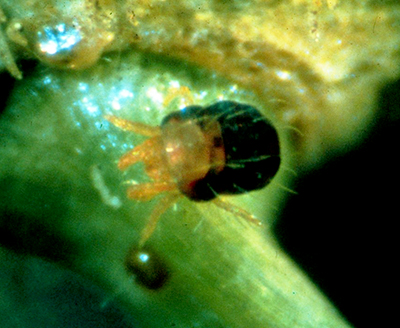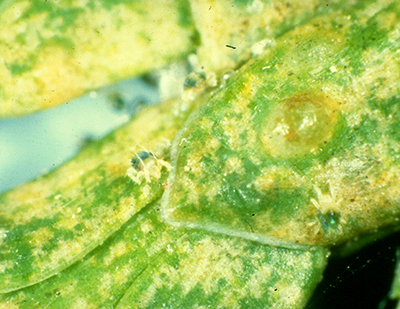Spruce spider mite management in Christmas trees for 2015
Spruce spider mites are an important pest of Christmas trees in Michigan. Minimizing insecticide use can help growers protect beneficial predatory mites that help keep this important pest in check.

Spruce spider mites (Oligonuchus umunguis) are an important pest of conifers in Michigan. This tiny insect can infest all species of commercially produced Christmas trees, regularly causing significant economic losses in spruce and Fraser fir plantings. Spruce spider mites are more commonly a pest in conventionally managed plantations that have lower predatory mite populations due to insecticide use. Predatory mites benefit growers because they feed on these pest mites and help keep populations in check; in their absence, spruce spider mite populations can flare leading to tree damage.
As spring approaches, growers should be prepared to ramp up their mite scouting programs. To scout for spruce spider mites, growers should sample multiple trees in each plantation and be sure to select trees from different elevations as well as from the interior and exterior rows of plantings. Larger tree samples will increase grower accuracy in their assessment of the population and potential risk. Scouting should be done on a season-long basis and not only after symptoms appear as this is often too late for effective treatment. The simplest way to scout for adult and juvenile mites is to shake or tap a branch over a scouting board or piece of paper (Photo 1).
Spruce spider mite eggs are a tiny, bright red sphere with a single hair in the center. Eggs that have already hatched will appear clear (Photo 2). Spruce spider mites are very small and soft-bodied during the motile stages. Adult spruce spider mites are one solid color, elliptical in shape and have hairs along the top of the abdomen. Coloration varies, but spruce spider mites are usually green, dark green or nearly black and never white, pink or light red. Beneficial predatory mites are usually white, cream, pink or light red and can also be distinguished from pest mites by observing their movement. When disturbed, adult predatory mites generally move more quickly than pest mites and can be observed moving speedily around on scouting boards. Spruce spider mite tends to crawl slowly.

Photo 2. Adult spruce spider mite with egg. Photo credit: USDA FS-Northeastern Area Archive, Bugwood.org
Symptoms of spruce spider mite damage include chlorosis, needle drop and patches of discolored or even brown foliage that may eventually expand to the entire tree. When viewing damage through a hand lens, symptoms appear as small, yellow, circular patches that surround the feeding sites (Photo 3). Spruce spider mite damage can be prevented through a combination of careful monitoring, resistance management and use of pesticides less harmful to natural predatory mites. The simplest way to determine the need for management is to evaluate if scouting indicates the population is growing or at a damaging level. It is important to remember spruce spider mite populations can fluctuate rapidly, so simply observing damage on trees is not an accurate indicator of the need for treatment as damage may have been caused by populations that have since died off, making a spray application pointless.

Photo 3. Spruce spider mite feeding damage on needle. Photo credit: John A. Weidhass, Virginia Polytechnic Institute and State University, Bugwood.org
The following table contains current treatment options, their chemical class, the life stage they target, relative efficacy, duration of control and relative toxicity to beneficial predatory mites. Spider mites are rarely a problem if insecticides are not being used because predator mites will keep them under control. Try to avoid insecticide sprays as much as possible to encourage natural control.
Control options for spruce spider mites for 2015
|
Chemical class |
Compound (active ingredient) |
Life stage target1 |
Efficacy |
Residual control |
Toxicity to predatory mites2 |
|
Pyrethroids |
Asana XL, S-fenvalostar (esfenvalerate), OnyxPro, Sniper (bifenthrine), Baythroid XL (cyfluthrin) |
Motiles |
Good |
4-6 weeks |
H |
|
Organophosphates |
Chlorpyrifos 4E AG, Govern 4E, Hatchet, Lorsban Advanced, Lorsban 4E, Lorsban 75WG, Nufos 4E, Quali-Pro Chlorpyrifos 4E, Warhawk, Whirlwind, Yuma 4E Insecticide, Vulcan (chlorpyrifos) |
Motiles |
Fair |
4-6 weeks |
H |
|
Avermectins3 |
Avid 0.15EC, Ardent 0.15EC, Lucid Ornamental, Nufarm Abamectin, Minx Quali-Pro Abamectin 0.15EC, Timectin 0.15ECT&O (abamectin) |
Motiles |
Good |
3-4 weeks |
M |
|
Neonicotinoids |
Admire Pro, Couraze 2F, Couraze 4F, Mallet 75WSP, Nuprid 1.6F, Pasada 1.6F, Prey, Provado 1.6F, Sherpa, Widow, Wrangler (imidacloprid) |
--- |
Poor |
--- |
M |
|
Tetronic acids |
Envidor 2SC Mitecide (spirodiclofan) |
Eggs, motiles |
Good |
6-8 weeks |
S |
|
Thiazoles3 |
Savey 50DF, Onager, Hexygon DF (hexythiazox) |
Eggs, larvae |
Good |
6-8 weeks |
S |
|
Carbazates |
Acramite 4SC, Floramite SC, Sirocco (bifenazate) |
Eggs, motiles |
Good |
4 weeks |
M |
|
Sulfite esters |
Omite (propargite) |
Motiles |
Good |
3-4 weeks |
S |
|
Horticultural oils4 |
Damoil (mineral oil), Purespray 10E, Purespray Green (petroleum oil) |
Eggs, motiles |
Good |
2-6 weeks |
S |
|
Quinolines |
Shuttle (acequinocyl) |
Eggs, motiles |
Good |
3-4 weeks |
M |
|
Quinazolines |
Magister, Magus (fenazaquin) |
Motiles |
Good |
6-8 weeks |
M |
|
Pyridazinone |
Sanmite (pyridaben) |
Eggs, motiles |
Good |
3-4 weeks |
M |
|
Insect growth inhibitors |
Apollo SC (clofentazine)5 |
Eggs, larvae, nymphs |
Good |
3-4 weeks |
S |
|
Insect growth regulators |
TetraSan (etoxazole) |
Eggs, larvae, nymphs |
Good |
4 weeks |
M |
1Motile Forms include mite larvae, nymph and adult stages.
2S-relatively safe to mite predators, M-moderately toxic, H-highly toxic.
3Avermectin, thiazole and tetronic acid miticides are slower acting, so growers should not be surprised if mites appear alive following application. It may take 7-10 days to see complete mortality.
4Horticultural oils can cause phytotoxicity, particularly when used in summer, and can lighten the blue coloring in blue spruce trees. A 1 percent concentration of a highly refined horticultural oil is usually a safe rate to spray anytime of the year, but a 2 percent or higher concentration may damage bloom on glaucous variations of spruce, and cause undesirable symptoms.
5The Apollo label should be read and followed carefully to ensure proper use and slow the development of insecticide resistance.
Pyrethroids, organophosphates and the avermectins all have good knockdown activity and residual control against the motile life stages of spruce spider mites, but their lethal effects on predatory mites makes them poor choices for treatment. The use of these materials often necessitates continued treatments during the season as natural enemy and predatory mite populations are depleted leading to spruce spider mite population flares. Neonicotinoids containing imdacloprid as the active ingredient are also a poor choice for spruce spider mite control and in some cases may actually contribute to spider mite outbreaks.
The carbazates, quinolones, pyridazinones, quinazolines and the insect growth regulator etoxazole all show good efficacy against spruce spider mites and are moderately toxic to predatory mites when compared to the aforementioned materials. Use of these materials presents a lower risk of mite flaring and provides three to four weeks residual control against all life stages of spruce spider mites, with the exception of etoxazole which has limited activity against adults.
The tetronic acids, thiazoles, sulfite esters and horticultural oils also show good efficacy against spruce spider mites with variable lengths of residual control. There is a risk of phytotoxicity and chlorosis with horticultural oils, so growers should proceed with caution with new products or when using on previously untreated species. The tetronic acids, thiazoles, sulfite esters and horticultural oils also have the important added benefit of being relatively safe to predatory mites and have a low potential to cause mite flaring.
Growers may find that more than one treatment is necessary, particularly under high population pressure or when utilizing an insecticide that isn’t active against all life stages. Carefully read the labels as some products are limited to one application per season. Check the base of needles and twigs for spruce spider mite eggs in early spring. If eggs are abundant, apply a horticultural oil at a 2 percent concentration to kill eggs before they hatch. A 2 percent concentration of a high quality horticultural oil is safe for most Christmas trees, with the exception of blue spruce which lose some of its blue glossy color after being sprayed with oil.
To delay the development of miticide resistance, Michigan State University Extension encourages growers to follow label suggestions limiting the number of applications of a given product in a season and also to select miticides from more than one class of insecticides. For example, growers may apply a dormant oil application in the spring followed by a tetronic acid application as populations begin to rebound. The next application should be from a class other than tetronic acids.
Changes in pesticide regulations occur constantly and the information provided in this article does not supersede label directions. To protect yourself, others and the environment, always read and follow the label.
This material is based upon work supported by the National Institute of Food and Agriculture, U.S. Department of Agriculture, under Agreement No. 2013-41534-21068. Any opinions, findings, conclusions, or recommendations expressed in this publication are those of the author(s) and do not necessarily reflect the view of the U.S. Department of Agriculture.



 Print
Print Email
Email


